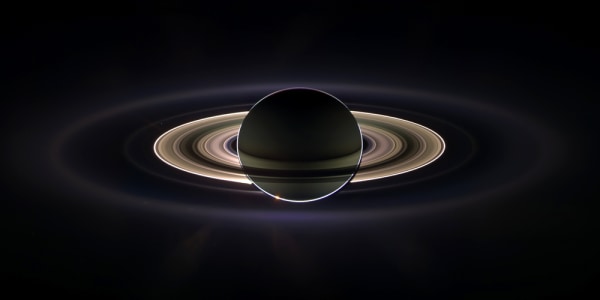Pictures snapped by the Titan probe and a low, whooshing sound picked up by an on-board microphone drew gasps and applause from scientists Saturday, as the mission to Saturn’s moon continued its breathtaking revelations from more than 900 million miles across the solar system.
Data beamed back from Titan, one of Saturn’s moons, sketched a picture of a pale orange landscape with a spongy surface topped by a thin crust.
“The closest analogues are wet sand or clay,” said John Zarnecki, in charge of instruments analyzing Titan’s surface.
'Blown away'
Scientists at the European Space Agency were clearly excited about the success of the mission, which had confirmed some long-held theories and produced startling surprises.
“I have to say I was blown away by what I saw,” lead scientist David Southwood said at the agency’s headquarters in Darmstadt. “It was an extraordinary experience to look at some of the stuff.”
Images taken on descent, from about 12 miles right down to the surface, suggest the presence of liquid, possibly flowing through channels or washing over larger areas, said Marty Tomasko of the Lunar and Planetary Laboratory at the University of Arizona in Tucson.
“It is almost impossible to resist speculating that the flat, dark material is some kind of drainage channel, that we are seeing some kind of a shoreline. We don’t know if it still has liquid in it.”
A thick layer of cloud or fog that obscures the planet was found to be hanging at about 12 miles from the surface, but absent closer to the ground.
The clouds are most likely methane and dark areas on the surface are “a reservoir” of liquid methane, said project scientist Shushiel Atreya.
Alien sound recorded
A boom mike extended from the 705-pound Huygens probe has captured a loud, rushing sound. Mission scientists did not immediately say what it might mean, but instruments on the probe have detected winds of about 15 mph.
Slideshow 14 photos
Best of Cassini
Titan is the first moon other than the Earth’s to be explored. Scientists believe its atmosphere may be similar to that of the primordial Earth and studying it could provide clues to how life began on our planet.
Huygens was spun off from the Cassini mother ship on Dec. 24 before it began its 2½-hour parachute descent on Friday, taking pictures and sampling the atmosphere before landing on Titan, where temperatures are estimated at 292 degrees below zero.
Scientists want to know whether Titan has lightning and if it has the seas of liquid methane and ethane that have been theorized. Both ethane and methane are gases on Earth, but are believed to exist in liquid form on Titan.
Mission officials had tears in their eyes as the first signal was picked up, indicating the probe was transmitting to the Cassini mother ship.
Glitch reduces image capacity
Despite exultation, scientists were disappointed after one of Huygens’ two data channels failed, robbing scientists of nearly half the hoped-for 700 images.
Except for the transmission glitch, all instruments on the $3.3 billion Cassini-Huygens mission to explore Saturn and its moons have worked as designed.
“The instruments performed brilliantly,” Zarnecki said. “We can’t find a single missing data frame. The link and the quality of the data was absolutely superb.”
The probe sent data to NASA’s Cassini mother ship above Saturn, which relayed them to the ESA by way of NASA. The mission was launched in 1997 from Cape Canaveral, Fla. — a joint effort by NASA, ESA and the Italian space agency. The two probes are named after 17th-century observers of Saturn: Jean Dominique Cassini, who discovered four of Saturn's moons as well as the major division within its rings; and Christiaan Huygens, who discovered Titan.
